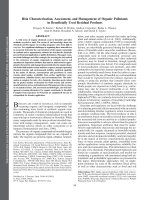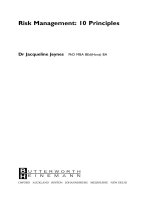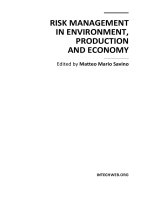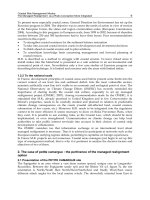Risk Assessment and Risk Management, I pps
Bạn đang xem bản rút gọn của tài liệu. Xem và tải ngay bản đầy đủ của tài liệu tại đây (459.94 KB, 9 trang )
1
Risk Assessment
and Risk Management, I
Principles of Environmental Toxicology
Instructor: Gregory Möller, Ph.D.
University of Idaho
Principles of Environmental Toxicology
2
Learning Objectives
• Develop a basic understanding of risk
assessment and its role within the risk
management process.
• Differentiate between risk assessment and risk
management.
• Develop a basic understanding of how to conduct
and evaluate an uncertainty analysis for a risk
assessment.
Principles of Environmental Toxicology
3
“Fear of danger is ten thousand times more
terrifying than danger itself.”
Daniel Defoe (1660-1731)
Principles of Environmental Toxicology
4
Risk: Perceptions and Preferences
• Experts and the public often disagree about risk.
• People will accept risks 1,000 greater if they are
voluntary (e.g. driving a car) than if they are
involuntary (e.g. a nuclear disaster) [Starr 1969].
• Risk attributes that lead to cognitive bias:
– Availability
• Imagining scenarios
– Anchoring
• Background knowledge
– Gain/Loss asymmetry
• Loss is value greater
– Threshold
• Adverse to uncertainty
Principles of Environmental Toxicology
5
Toxicology and Risk Analysis
• Risk analysis is broadly defined to include
risk assessment, risk characterization,
risk communication, risk management,
and policy relating to risk.
Society of Risk Analysis
Principles of Environmental Toxicology
6
Toxicology and Risk Analysis
• Risk assessment
– Scientific evaluation of the probability of harm resulting from exposure
to toxic substances. (EPA)
• Risk characterization
– A description of the nature and magnitude
of health risk that combines
results of exposure assessment and hazard identification and
describes the uncertainty
associated with each step. (NAS)
• Risk communication
– The science of communicating effectively in situations that are of high
concern, sensitive, or controversial. Risk communication principles
serve to create an appropriate level of outrage, behavior modification,
or mitigating response, that is in direct proportion to the level of risk or
hazard. (Risk Communication Network)
• Risk management
– Risk management is the decision-making process involving
considerations of political, social, economic and science/engineering
factors with relevant risk assessments relating to a potential hazard so
as to develop, analyze and compare options and to select the optimal
response for safety from that hazard. (Intl. Risk Governance Council)
2
Principles of Environmental Toxicology
7
Risk Triad
Principles of Environmental Toxicology
8
Risk Assessment
• Ecological Risk Assessment (ERA).
• Human Health Risk Assessment.
Principles of Environmental Toxicology
9
Ecological Risk Assessment
• Ecotoxicology
– The study of the ways in which polluting agents disturb
biological populations and communities.
• Ecological risk assessment.
– Ecological field surveys in terrestrial and aquatic
environments.
– Fate and transport modeling.
– Toxicity testing.
– Bioaccumulation studies.
– Risk characterization.
• Population, community
and ecosystem levels.
Principles of Environmental Toxicology
10
Human Health Risk Assessment
• Predictive modeling of the threat to human health
posed by the exposure to toxicants.
• For constituents that are systemic toxicants, the threat
can be expressed in terms of a hazard quotient.
• Hazard Quotient = Dose ÷ Toxicity Factor.
– Toxicity factor can be
“maximum safe intake”
– A hazard quotient ≤ 1.0
is typically regarded as
acceptable
Principles of Environmental Toxicology
11
Fundamentals of HHRA
• Systemic toxicity is a threshold phenomenon.
– Increasing exposure (dose) of a chemical will cross a
threshold when biological effects will start to occur.
– The dose is the total dose attributable all routes of
exposure.
• Cancer: non-threshold
• Toxicity factors for systemic
toxicants are reference doses.
– i.e., the “no effect” level.
• Dose and reference dose units.
– mg of constituent per kg
receptor body weight per day,
or mg/(kg·d).
Principles of Environmental Toxicology
12
Fundamentals of HHRA
Dose is modeled with the following general equation
(unit conversion factors are used as needed); e.g.:
Dose = CC × CR × EF ÷ (BW × UCF)
• CC — constituent concentration in the medium of potential
concern (e.g., mg/L).
• CR — contact rate with the medium
of potential concern (L/d).
• EF — exposure frequency with the
medium of potential concern
(d/yr).
• BW — body weight (kg).
• UCF — unit conversion factor
(e.g., d/yr).
3
Principles of Environmental Toxicology
13
Risk Models
Cell P2 Frequency Chart
log (Risk)
Mean = -6
2,995 Trial
s
.00
.01
.02
.03
.050
0
37.7
75.5
113
151
-10 -8 -6 -4 -2
Forecast: log ILCRocc
Š
• Deterministic: point estimates
– Straight-forward; easier risk communication
• Probabilistic (stochastic): distributions
– Uncertainty quantified; statistical representations
Principles of Environmental Toxicology
14
Risk Models: Deterministic vs. Probabilistic
0.00 11.75 23.50 35.25 47.00
Exposure Duration (years)
ED
0 2,000 4, 000 6,000 8,000
Exposure (EF*ET -hr/yr)
EF
29.26 30.69 32.11 33.54 34. 96
Concentration
CC
36.53 61.22 85.92 110.61 135.30
Body Wei ght (kg)
BW
1.53e-7 1.35e-5 2.6 7e-5 4.00e-5 5.33e-5
Toxici ty Factor (mg/kg d)
TF
CR
RISK
2.39 298.68 594.98 891.27 1,187.57
Contact Rate
Risk = TF x CC x CR x EF x ED
BW
0.00 0.00 0.00 0.00 0.00
A1
Principles of Environmental Toxicology
15
Principles of Environmental Toxicology
16
Assessment vs. Management
• Separate, but integrated, processes.
• Risk manager’s mission: protect human health.
– i.e., be conservative.
• Risk assessor’s mission: provide risk manager with
best information possible.
– i.e., be honest.
– Traditional deterministic
(i.e., point-estimate) risk
assessments can confound
risk assessment with risk
management by compounding
conservative assumptions.
Principles of Environmental Toxicology
17
Risk Assessment Framework
3. Risk Characterization
3. Risk Characterization
2. Analysis
2. Analysis
1. Problem Formulation
1. Problem Formulation
Risk Assessment
Risk Assessment
Exposure
Exposure
Assessment
Assessment
Toxicity
Toxicity
Assessment
Assessment
EPA
Principles of Environmental Toxicology
18
Problem Formulation
Constituent
Constituent
Screening
Screening
Conceptual
Conceptual
Model
Model
Exposure
Exposure
Screening
Screening
Receptor
Receptor
Screening
Screening
Analysis
Analysis
Problem Formulation
Problem Formulation
EPA
4
Principles of Environmental Toxicology
19
Analysis
Toxicity
Toxicity
Database
Database
Receptor
Receptor
Characterization
Characterization
Toxicant
Toxicant
Classification
Classification
Dose
Dose
-
-
Response
Response
Analysis
Analysis
Exposure
Exposure
Analysis
Analysis
Constituent
Constituent
Characterization
Characterization
Problem Formulation
Problem Formulation
Exposure Assessment
Exposure Assessment
Toxicity Assessment
Toxicity Assessment
Analysis
Analysis
Risk Characterization
Risk Characterization
EPA
Principles of Environmental Toxicology
20
Risk Characterization
Analysis
Analysis
Risk Description
Risk Description
•
•
Risk summary.
Risk summary.
•
•
Interpretation of significance.
Interpretation of significance.
Risk Characterization
Risk Characterization
Risk Estimation
Risk Estimation
•
•
Exposure and toxicity
Exposure and toxicity
assessment integration.
assessment integration.
•
•
Uncertainty analysis.
Uncertainty analysis.
EPA
Principles of Environmental Toxicology
21
RA Framework Summary
• Risk assessment: predictive modeling of potential
human health threats.
• Risk assessment vs. risk management: distinct,
but integrated processes.
• Risk assessment framework.
– Problem formulation.
– Analysis.
– Risk characterization.
• An iterative process.
Principles of Environmental Toxicology
22
Problem Formulation
• Screening.
– Identification of constituents of potential concern.
– Identification of receptors of potential concern.
– Identification of exposure pathways of potential concern.
• Conceptual modeling.
Principles of Environmental Toxicology
23
Constituent Screening
• Determine if [X] is a constituent of potential concern.
–[X] → Applicable regulatory criterion?
–[X] → Site-specific background distribution?
–[X] → Conservative site specific objective?
Principles of Environmental Toxicology
24
Receptor Screening
Identification of
Identification of
Site Receptor Populations
Site Receptor Populations
Of Potential Concern
Of Potential Concern
Current and Future
Current and Future
Air Use
Air Use
Current and Future
Current and Future
Land Use
Land Use
Current and Future
Current and Future
Water Use
Water Use
Agricultural
Agricultural
Commercial
Commercial
Industrial
Industrial
Residential
Residential
Recreational
Recreational
EPA
5
Principles of Environmental Toxicology
25
Principles of Environmental Toxicology
26
Exposure Pathway Screening
• Volatilization?
• Dust, Particulates?
– Settling to water, populations?
• Release to surface water, sediments?
– Drinking water, aquatic wildlife,
groundwater, irrigation.
• Release to soils?
– Groundwater, wells,
agriculture, food chain
biota.
Principles of Environmental Toxicology
27
Conceptual Modeling
• Summarizes and documents results of constituent,
receptor, and exposure pathway screening.
• Forms the basis for subsequent quantitative modeling.
• Effective tool for communication and management.
Principles of Environmental Toxicology
28
Problem Formulation Summary
• Primarily a screening exercise.
• An exercise in conceptual model development
assisted by rapid and simple quantitative modeling.
• Used to focus subsequent, intensive efforts, if any, on
those variables and sub-processes
which are likely to contribute
most to the risk estimate.
Principles of Environmental Toxicology
29
Problem Formulation Summary
• Developing a working definition of “exposed
population” (i.e., the receptor population of potential
concern) may take more art than science.
Principles of Environmental Toxicology
30
Problem Formulation Summary
• Quantitative aspects of screening constituents,
pathways, and receptors are generally carried out
deterministically.
• Future site use assumptions are important.
• Excellent process for project planning, not just as the
first phase of a risk
assessment carried out
at the end of a site
investigation.
• Really an ongoing process.
6
Principles of Environmental Toxicology
31
Principles of Environmental Toxicology
32
Analysis
• Exposure assessment.
– Constituent characterization.
– Receptor characterization.
– Exposure analysis.
• Toxicity assessment.
– Toxicant classification.
– Toxicity databases.
– Dose-response analysis.
Principles of Environmental Toxicology
33
Exposure Assessment
Problem Formulation
Problem Formulation
Receptor
Receptor
Characterization
Characterization
Constituent
Constituent
Characterization
Characterization
Exposure
Exposure
Analysis
Analysis
Risk Characterization
Risk Characterization
Exposure
Exposure
Assessment
Assessment
Toxicity
Toxicity
Assessment
Assessment
EPA
EPA
Principles of Environmental Toxicology
34
Exposure Assessment
• Best opportunity to introduce site specificity.
• Usually the most intensive aspect of quantitative
risk modeling.
• Substantial amount of information available, and
much of it is readily available.
• Need to consider bioavailability adjustment.
• For carcinogens, need to
focus on incremental
cancer risk.
Principles of Environmental Toxicology
35
Exposure Assessment
• For systemic toxins, need to consider dietary
intake.
– Qualitative consideration may suffice.
• Need to consider correlations.
• Need to consider spatial and temporal variability.
• Need to include likelihood
of scenario occurrence
in exposure quantifications.
Principles of Environmental Toxicology
36
7
Principles of Environmental Toxicology
37
Toxicity Assessment
Problem Formulation
Problem Formulation
Toxicity
Toxicity
Database
Database
Toxicant
Toxicant
Classification
Classification
Dose
Dose
-
-
Response
Response
Analysis
Analysis
Risk Characterization
Risk Characterization
Exposure
Exposure
Assessment
Assessment
Toxicity
Toxicity
Assessment
Assessment
EPA
EPA
Principles of Environmental Toxicology
38
Toxicity Assessment
• Usually the most over-rated aspect of risk modeling,
but often the most uncertain component.
• Good databases available.
• Most toxicity factors have enormous amount of lack of
knowledge that is hard to reduce.
– Expense of toxicological studies.
– Inherent ignorance in
extrapolating from animals
to humans.
• Bioavailability adjustments.
Principles of Environmental Toxicology
39
Risk Characterization
• Risk estimation.
– Exposure and toxicity assessment integration.
– Uncertainty analysis.
• Risk description.
– Risk summary.
– Risk interpretation.
Principles of Environmental Toxicology
40
Risk Characterization
Analysis
Analysis
Risk Description
Risk Description
•
•
Risk summary.
Risk summary.
•
•
Interpretation of significance.
Interpretation of significance.
Risk Characterization
Risk Characterization
Risk Estimation
Risk Estimation
•
•
Exposure and toxicity
Exposure and toxicity
assessment integration.
assessment integration.
•
•
Uncertainty analysis.
Uncertainty analysis.
EPA
Principles of Environmental Toxicology
41
Principles of Environmental Toxicology
42
Risk Description
• Summarization
– Give a picture of the risk estimate.
– Focus on the 95th percentile estimate.
– Acknowledge the uncertainty.
• Interpretation
– Put the estimated risk into a regulatory perspective.
– Put the estimated risk into a real-world perspective.
8
Principles of Environmental Toxicology
43
Risk Characterization Summary
• Explain uncertainty of risk estimate.
– Descriptive statistics, sensitivity to independent variables,
and contributions of major model components; conduct
value-of-information analysis and provide
recommendations, if any, for further work.
• Focus on the 95th percentile
of the risk estimate.
• Put the risk into regulatory
and real-world contexts.
Principles of Environmental Toxicology
44
Principles of Environmental Toxicology
45
Assessment vs. Management
• Integrated, but separate, processes.
• Different missions.
– Risk manager—be protective.
– Risk assessor—be unbiased.
• Precaution required so
as to not confuse the two
missions and processes.
Principles of Environmental Toxicology
46
Overview of Statistics
• Statistical descriptors.
• Spatial and temporal analyses.
Principles of Environmental Toxicology
47
Measures of Central Tendency
• Mean, μ
• Median, p
0.50
• Mode, m
Principles of Environmental Toxicology
48
Measures of Uncertainty
• Standard deviation, σ
• Variance, σ
2
• Coefficient of variation, σ/μ
• Range, υ-λ
• Informational entropy, H
9
Principles of Environmental Toxicology
49
Spatial & Temporal Analyses
• Geostatistics.
• Trend analysis.
• Predictive modeling.
Principles of Environmental Toxicology
50
Fundamental Probability Concepts
• Central Limit Theorem.
– The sum of an infinite number of distributions, regardless of
their form, is a normal distribution.
– The product of an infinite number of distributions, regardless
of their form, is a lognormal distribution.
• Uncertainty.
• Distribution development.
• Correlation analysis.
• Uncertainty, sensitivity,
contribution, and
value-of-information analyses.









